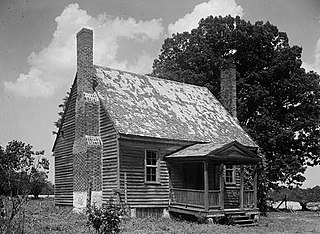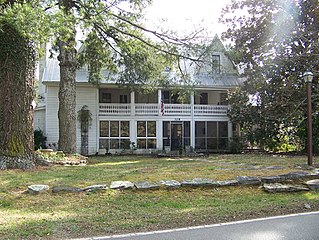
Old Salem is a historic district of Winston-Salem, North Carolina, United States, which was originally settled by the Moravian community in 1766. It features a living-history museum which interprets the restored Moravian community. The non-profit organization began its work in 1950, although some private residents had restored buildings earlier. As the Old Salem Historic District, it was declared a National Historic Landmark (NHL) in 1966, and expanded fifty years later. The district showcases the culture of the Moravian settlement in the Province of North Carolina during the colonial 18th century and post-statehood 19th century via its communal buildings, churches, houses and shops.

Horne Creek Farm is a historical farm near Pinnacle, Surry County, North Carolina. The farm is a North Carolina State Historic Site that belongs to the North Carolina Department of Natural and Cultural Resources, and it is operated to depict farm life in the northwest Piedmont area c. 1900. The historic site includes the late 19th century Hauser Farmhouse, which has been furnished to reflect the 1900-1910 era, along with other supporting structures. The farm raised animal breeds that were common in the early 20th century. The site also includes the Southern Heritage Apple Orchard, which preserves about 800 trees of about 400 heritage apple varieties. A visitor center includes exhibits, a gift shop and offices.
George Washington Logan was a prominent North Carolina politician who served in the Confederate States Congress during the American Civil War as a peace and Unionist candidate.
Davidson House is a historic home located near Troutman, Iredell County, North Carolina. The original section was built about 1805, and enlarged and remodeled in the Federal period about 1830. It is a 1+1⁄2-story, two bay by two bay, log dwelling sheathed in weatherboard. It has a hall and parlor plan, front shed porch, rear shed rooms and porch, and a single should brick chimney. Also on the property is a contributing two-story three-bay wide, half-dovetail log barn.

The George Houston House, also known as the "Wall-Houston House", is a private historic home between Mooresville and Davidson, North Carolina in Iredell County that was built in 1818. The original portion of the home was built with log construction, and several later additions, including a 19th-century ell. In its nomination, the home's original Federal-style construction was noted as being highly representative of the idiosyncrasies found in home designs in Iredell County and the North Carolina Piedmont during the Federal era. The property on which the home sits also contains several historic outbuildings, including an early log barn.

Latta Place, also known as Latta House, is a historic house located in Huntersville, North Carolina near Mountain Island Lake. Built in about 1800 in a Federal style, the plantation also contains some elements of Georgian design, including the house's main staircase.

The Logan Square Boulevards Historic District is a linear historic district in the Logan Square community area of North Side, Chicago. It encompasses 2.5 miles (4.0 km) of the Chicago boulevard system.
William Teague House is a historic home located near Siler City, Chatham County, North Carolina. It was built in several sections built at various times during the first half of the 19th century. The property consists of a two-story log cabin dating from the 1820s-1830s; a 1+1⁄2-story, one room log section; and a rear shed and side frame addition. The house exhibits vernacular Federal and Greek Revival design elements. Also on the property are a contributing small corn crib and a smokehouse.

Dr. E. H. Ward Farm is a historic home and farm located near Bynum, Chatham County, North Carolina. The main house was built in sections during the mid-19th through early-20th century beginning about 1840. The earliest section is a 1+1⁄2-story, gable-roofed, two room log structure, that forms the rear of the main section. The main section was built about 1870, and is a one-story, gable-roofed frame structure with a simple gable-front porch. A one-story board-and-batten rear ell was added about 1900. Also on the property are the contributing office of Dr. Ward, carriage house and gear room, board-and-batten barn and log cribs, smokehouse and pen, and a small brick well house.
Whitehead-Fogleman Farm is a historic home and farm located near Crutchfield Crossroads, Chatham County, North Carolina. The main house was built about 1838, and is a two-story, Federal style frame dwelling. Also on the property are the contributing saddle-notch log corn crib, a square-notch log and board-and-batten well house, a large V-notch log barn, and a one-room board-and-batten kitchen.
Goodwin Farm Complex is a historic home and farm located near Bells, Chatham County, North Carolina. The complex was established during the period 1850–1860. The main house consists of the original combined log cabin and detached kitchen in a one-story triple-A frame house, with a two-story section added about 1900. Also on the property are late-19th century agricultural outbuildings.
Leigh Farm is a historic home and plantation complex located near Chapel Hill, Durham County, North Carolina. The house was built about 1834, and is a one-story, three-bay, frame dwelling with a broad gable roof. Also on the property are the contributing frame gable-roof well, dairy, smokehouse, log slave quarters, a log dwelling, corn crib, frame carriage house, and log tobacco barn.

Cascine is a historic plantation complex and national historic district located near Louisburg, Franklin County, North Carolina. The district encompasses 12 contributing buildings, 4 contributing sites, and 3 contributing structures. The main house was built about 1850, and is a large two-story, Greek Revival style frame dwelling, in the manner of Jacob W. Holt, with Gothic Revival style influences. Also on the property is a small, one-story frame dwelling dated to about 1752. It was repaired and refurbished in the mid-20th century. Also on the property are the contributing brick kitchen, frame stable, granary, carriage house, family cemetery, slave cemetery, remains of slave quarters, tenant house, six log and frame tobacco barns, grist mill complex, and archaeological sites.

Daltonia, also known as the John H. Dalton House, was a historic home located near Houstonville, Iredell County, North Carolina. It was built in 1858, and is a two-story, three-bay by two-bay, Greek Revival style frame dwelling. It has a gable roof, two-story rear ell, and the front facade features a two-story pedimented portico. Also on the property is a contributing 1+1⁄2-story small log house and a loom house.
Waddle–Click Farm is a historic home and farm complex located near Statesville, Iredell County, North Carolina. The Federal style house was built between about 1820 and 1835, and is a two-story, three bay by two bay, log dwelling. Also on the property are a contributing well house, smokehouse, log slave cabin, granary / corn crib, hay barn / stable, and a shed.
Paisley-Rice Log House is a historic home located near Mebane, Orange County, North Carolina. It believed to date to the late-18th century. The log dwelling is composed of two sections and follows the three-room Quaker plan, or Continental Plan. Located between the two sections is a chimney. The interior features vernacular Georgian woodwork.
Melton–Fortune Farmstead is a historic home and farm located near Golden Valley, Rutherford County, North Carolina. The oldest section of the house was built about 1796, and is a rectangular, hall-and-parlor plan, log structure that forms two rooms of the central core. The house is a 1 1/2-story, weatherboarded structure with an engaged porch and Federal style design elements. Also on the property are the contributing log barn, threshing machine, and archaeological sites.

Pine Gables, also known as Logan House and Harris Inn, is a historic inn complex and national historic district located near Lake Lure, Rutherford County, North Carolina. The property encompasses 10 contributing buildings, 5 contributing sites, and 3 contributing structures. The original log sections of the inn dates to about 1800, and enlarged and modified in 1834, 1877, and 1924. It is a 2 1/2-story, frame building with high pitched gables in a vernacular Queen Anne style. Also on the property are the contributing Old Tearoom now used as a single family dwelling, a one-story stone structure, seven guest cabins, a craft shop, rock wall, three ponds, a segment of Old Highway 20, and the shoreline of Lake Lure. Judge George Washington Logan (1815-1889), who also owned the George W. Logan House at Rutherfordton, bought the inn in 1866 and it became known as the "Logan House". During the Great Depression, the inn and surrounding property was used to promote economic recovery as a Civilian Conservation Corps (CCC) headquarters.
Hollingsworth–Hines Farm is a historic home and farm complex and national historic district located near Turkey, Sampson County, North Carolina. The house was built between 1785 and 1800, and is a two-story, log dwelling with a later rear ell. Also on the property are a number of contributing farm outbuildings, most notable are two log smokehouses, the large six stall barn, two handsome packhouses, a very unusual arrangement of three connected tobacco barns and the family cemetery.

Claymont Hill, also known as the Albert L. Hendrix House, is a historic home located near Ronda, Wilkes County, North Carolina. It was built in 1870, and is a large two-story, ell-shaped I-house with multiple gables and with two-story porches on three elevations. At its core is a much earlier log structure. It has Gothic Revival style design elements in the gables and sawnwork trim. Also on the property is a contributing former detached kitchen.














